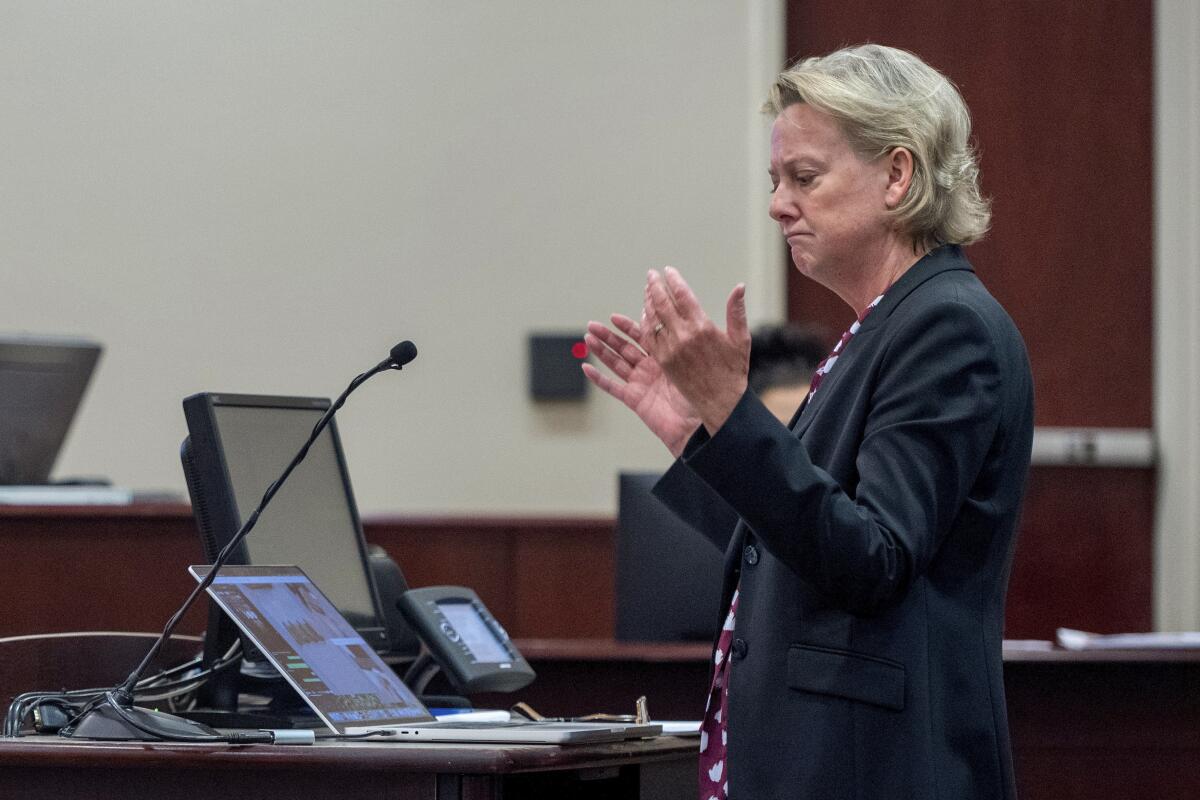Entertainment
'Baby Reindeer,' Richard Gadd's breakout Netflix series, receives 11 Emmy nominations

Netflix’s “Baby Reindeer,” the British drama that became one of the most controversial and buzzed-about series of the year, has now become a major contender in the Emmys race, scoring 11 nominations in the limited series category.
“Baby Reindeer” tells the story of Donny Dunn, an aspiring comedian moonlighting as a bartender, whose encounters with an eccentric woman named Martha at the pub where he works become increasingly uncomfortable and sinister. The series was created and written by Richard Gadd, who stars as Donny. On Wednesday, it nabbed nominations for limited series, actor (Gadd), supporting actor (Tom Goodman-Hall) and supporting actress (Jessica Gunning and Nava Mau). The series also was nominated for writing and directing.
Jessica Gunning co-starred as Martha in “Baby Reindeer.”
(Ed Miller / Netflix)
Adapted from Gadd’s autobiographical one-man play — the title card at the start of each episode states that it is “a true story” — “Baby Reindeer” became an instant sensation when it launched on Netflix in April. Viewers were fascinated with its mix of comedy and drama, punctuated with disturbing depictions of sexual assault and mental health. Critics gave high praise to the cast, particularly the performances of Gadd and Gunning. It spent eight weeks on Netflix’s global top 10 list, making it one of the streamer’s most watched series of the year.
The show and the events it depicted also sparked investigations by armchair detectives who tried to figure out the true identities of the characters on the show, particularly Martha and Darrien (Goodman-Hill), a television writer who sexually assaults Donny. In an interview with The Times in April, Gunning called her performance as Martha, who stalks Donny, an “interpetation” of Gadd’s vision and said she never asked him about her real-life counterpart.
However, in the months since the show’s premiere, Fiona Harvey, a 58-year-old Scotswoman, claimed to be the basis for Martha in an interview with Piers Morgan on his YouTube channel. She sued Netflix in June, seeking $170 million in damages for what she called defamation and emotional distress. A Netflix spokesperson said in a statement about the suit: “We intend to defend this matter vigorously and to stand by Richard Gadd’s right to tell his story.”

Movie Reviews
Movie Review: A new generation drives into the storm in rousing ‘Twisters’

We have a complex relationship with disaster movies. Just look at the discussion about a “ Twisters ” poster, which became a perfect encapsulation of our love-hate tendencies.
In the promo for the film, in theaters Thursday, actors Daisy Edgar-Jones, Glen Powell and Anthony Ramos are standing in front a massive, menacing cyclone. It not only contains various objects swirling in mid-air, from houses to trucks, but also appears to be on fire. Some people wondered why the stars weren’t looking at said tornado. Others said if you’re asking questions like why the tornado is on fire, this movie isn’t for you.
Both lines of thought can be true though. Maybe their coexistence is essential. This makes no sense! Also, sign me up immediately! Disaster movies are almost required to be graded on a curve. And filmmaker Lee Isaac Chung’s entry into the canon is perfectly paradoxical.
It might not be fair, or rational, but there is something about the genre that inspires otherwise reasonable moviegoers to giddily give themselves over to a wild premise — the more ridiculous and illogical the better. There is something to be said about the joy of collective laughter where there wasn’t an intentional joke, or a spirited post-movie debate about the flawed logistics of a plan and exactly how many people have died from being sucked into a tornado. These are the movies that are hard to see clearly the first time but tend to become sneaky favorites over the years.
Such is the case with “Twister,” Jan de Bont’s film about storm chasing and remarriage. The modern collective love for it would probably surprise even the critics who reviewed it favorably in 1996. Part of that is certainly the fact that in the 28 years since it was released we lost both Philip Seymour Hoffman and Bill Paxton. But it’s also just fun to watch with fresh eyes, to see the internet remember (or realize for the first time) that one of the storm chasers was played by Todd Field, the man who would go on to write and direct “Tár.” I re-watched it recently on plane and had a blast. I’d forgotten the insane opening but remembered Dusty’s impassioned foot chant.
There’s been a lot of cautious optimism surrounding “Twisters” that’s felt different from a lot of the reboots and “new chapters” (anything to avoid calling it a sequel) that have come and gone in recent years. Audiences are craving something big and fun, but worried that it won’t live up to their idea of what it should be. This is inherently flawed because “Twister” has earned its reputation, its quotability, across many viewings and many years. “Twisters” we’re just meeting. It’s hard to get too excited about a first date.
But Chung, a filmmaker best known for the comparatively small “Minari,” has made a solid film with escalating action sequences that look great on the big screen. There is once again a crazy opening that gives Edgar-Jones’ tornado-obsessed Kate a trauma origin story. Her hubris in thinking she could “tame” a tornado with science backfired and people died; But five years later her old friend Javi (Ramos) convinces her to come back to Oklahoma’s Tornado Alley to attempt a different kind of study.
The story is credited to Joseph Kosinski (who was once going to direct) and the screenplay to Mark L. Smith (“The Revenant”) and none of them can get the original out of their heads. Yes, these are all new characters (including Powell’s YouTube star storm wrangler Tyler) and the only real connection to the first movie is that the Dorothy technology exists. But it is so referential as to be distracting: Literal lines of dialogue (“I’m not back”); An attempt to make Tyler’s crew a gang of Dustys (which underserves actors like Sasha Lane and Katy O’Brian); Making David Corenswet wear what’s essentially a recreation of Carey Elwes’ baseball cap and earpiece. Don’t they want us to think of “Twisters” on its own terms?
But Chung clearly also had a vision, attempting to ground the insanity in a real place with regionally appropriate styles and music, and deeper characterization. The supporting players were thoughtfully cast. Its leads, Powell and Edgar-Jones, are endlessly watchable with palpable chemistry, even as they’re monologuing about sodium polyacrylate.
I wish I had the ability to know how “Twisters” will play 28 years from now, in 2052. Will the 12-year-olds seeing it this weekend go back to it as a comfort watch? Will it feel like it was part of the good old days of big studio movie making? Right now, it doesn’t necessarily feel like it’s destined for that kind of longevity. And I’d love nothing more than to be wrong about that.
“Twisters,” a Universal Pictures release, is rated PG-13 by the Motion Picture Association for “intense action and peril, injury images, some language.” Running time: 122 minutes. Two and a half stars out of four.
Movie Reviews
CathayPlay Short Film Review: Dissociated State by Punk Zhang

“Working in a factory is not for girls”
Independent film punk Zhang, also known as Peng Zhang, is a film director, holds a Bachelor’s degree in Architecture, an MFA, and is also a sociological researcher and visual artist. His work “Disassociation” has received the “Zhang Xianmin Top 10 Recommendations – 3” award and special recognition at the Chongqing Youth Film Festival. He is a pioneer in the self-media film industry, as well as one of the initiators of the proletarian film movement. As the founder of the Proletariat Film Club (PFC), his experimental proletarian films on self-media platforms have gained a considerable audience. “Dissociated State” is a student film project from the School of Film at Chongqing University.
Watch This Title
on CathayPlay by clicking on the image below
Liang Guo is a subculture youth who is quite artistic, but she couldn’t get into university and doesn’t want to study. She only wants to hang out with her friend Hu Chuan Chun and deal with her art, which is the reason she could not get into higher education as her mother wanted. Her mother loves her but she does not understand her, which is why she pressures her to work in a factory. Guo perceives her attitude as tough love, and is in desperate need of understanding, but she cannot find her from her mother. Eventually, both friends are forced to work in a factory.
Punk Zhang directs a film that takes an intense arthouse approach towards its narrative, including elements of family drama and road trip, as much as intertitles, which are implemented to showcase her inner thoughts. The meticulous framing and the quality of compositions are definitely the highlight, with both the close ups and the long shots being impressive to watch, additionally for the placement of the actors in them.
Context-wise, the movie unfolds in two axes. The first is the relationship of Liang Guo and her mother, with the tension among them being palpable, also highlighting the difference of the two generations. Evidently, for the mother, dealing with art is just a hobby, which is why she pushes her daughter to get a job in a factory, essentially forcing her out of the house. The scene where Liang Guo hugs her and is pushed away is a highlight of the movie and also quite indicative of their relationship.
The second axis is the setting the two protagonists inhabit, where being forced to do manual work, essentially in order to be a “productive” member of society, is the rule. The way the protagonist refers to her upcoming job, “working in a factory is not for girls” also hints at the situation in similar workplaces. At the same time, and in the way their whole path towards the factory looks like a funeral procession of sorts, as the descent into hades one could say, stresses this fact even more.
The acting follows the same arthouse approach with the narrative, with very few lines here and there, and the mother being the one that does the most talking. This aspect highlights the protagonist’s mentality, who is anything but social and also functions as a metaphor for youths not having a voice in capitalist China, which is essentially the main message of the movie. The editing results in a relatively slow pace, which connects the vignette-type of sequences in fitting fashion. The use of music borders on the pretentious on occasion, and could have been handled better on occasion.
Exclusively addressed to arthouse fans, “”Dissociated State” is a well-constructed film that manages to communicate its messages eloquently, and one that is definitely on a much higher level than the usual student film.
Entertainment
Amid Baldwin furor, 'Rust' armorer Hannah Gutierrez wants her case dismissed too

Days after New Mexico’s case against Alec Baldwin collapsed amid allegations of evidence concealment in the “Rust” shooting, armorer Hannah Gutierrez asked a judge to dismiss her case as well.
Gutierrez’s lawyer, Jason Bowles, filed a 23-page motion late Tuesday asking that either Gutierrez’s involuntary manslaughter conviction be overturned or that she receive a new trial due to “severe and ongoing discovery violations by the state.” Bowles alleged the proceedings against Gutierrez were unfair because the state also withheld evidence in her case.
Gutierrez is currently serving an 18-month sentence for her role in the shooting death of “Rust” cinematographer Halyna Hutchins on the low-budget western set on Oct. 21, 2021.
The move comes as New Mexico’s legal world reels from disclosures made during a dramatic hearing on Friday, in which New Mexico First Judicial Circuit Court Judge Mary Marlowe Sommer dismissed the felony criminal charge against Baldwin — abruptly ending the actor’s high-profile trial.
The judge became alarmed after Baldwin’s attorneys alleged misconduct, including alleged collusion between the prosecutor and Santa Fe County sheriff’s deputies to conceal potential evidence — a bag of ammunition — from defense attorneys.
Judge Mary Marlowe Sommer, center, questions special prosecutor Kari Morrissey, second from left, about evidence not turned over to defense attorney Alex Spiro, second from right, during actor Alec Baldwin’s trial July 12.
(Eddie Moore / Associated Press)
A bag of cartridges that a retired law enforcement officer, Troy Teske, had turned over to the Santa Fe County Sheriff’s Office in March after Gutierrez’s trial ended is at issue. Teske, a friend of Gutierrez’s stepfather Thell Reed, had offered the evidence to prosecutors late last fall, but special prosecutor Kari T. Morrissey declined.
Morrissey has said that, after looking at a photo of the cartridges, she determined they did not match the live “Rust” ammunition. The sheriff’s crime scene technician also testified last week that the bullets were not like those found on “Rust.”
However, after Marlowe Sommer donned blue latex gloves and opened the evidence bag in a dramatic hearing on Friday, it was revealed that three of the shell casings were stamped with Starline Brass, which was an identifying characteristic of the “Rust” bullets.
Despite warnings from the judge that she did not have to testify, Morrissey took the witness stand to give sworn testimony about her handling of the Teske ammunition and the Baldwin case.
Shortly before, Morrissey’s co-counsel, Erlinda O. Johnson, resigned from the case. Johnson told NewsNation’s Chris Cuomo that she stepped down because Morrissey had told her she hadn’t seen the ammunition before — but that appeared not to be the case.
“We have an obligation as prosecutors … our obligation is to make sure all the evidence gets turned over,” Johnson told Cuomo. “We don’t get to decide what the defense is going to be.”
Morrissey, via email, said she would provide a written response to the Gutierrez motion.

Special prosecutor Kari Morrissey talks about evidence not turned over to the defense during actor Alec Baldwin’s trial for involuntary manslaughter for the 2021 fatal shooting of cinematographer Halyna Hutchins.
(Eddie Moore / Associated Press)
Last week, she testified that she did not believe the Teske rounds had evidentiary value because they had never left Arizona. The “Rust” shooting occurred outside Santa Fe, N.M. Teske was in Santa Fe for Gutierrez’s trial in March. He was scheduled to testify on behalf of Gutierrez, but Bowles did not call him to the stand.
The rounds were allegedly part of a batch that had been supplied to “Rust” weapons and ammunition provider Seth Kenney. Baldwin’s attorneys alleged that Kenney may have co-mingled live bullets with so-called dummies — an allegation that Kenney has long denied.
Bowles also pointed to an interview of Kenney, which wasn’t disclosed to the defense until after Gutierrez was convicted.
“Ms. Gutierrez-Reed respectfully requests this Court order a new trial or dismissal of the case for egregious prosecutorial misconduct,” Bowles wrote in Tuesday’s motion.

Actor Alec Baldwin, left, at his trial July 12 for involuntary manslaughter for the 2021 fatal shooting of cinematographer Halyna Hutchins.
(Ramsay de Give / Associated Press)
Bowles argued that, among the allegations of misconduct that came to light last week, crime scene technician Marissa Poppell “had been directed to place the Teske rounds in a separate case file with a separate number (not Rust) and create a report that was also filed in that separate case file so that these would not be disclosed to the defense,” he wrote in the Gutierrez court filing.
Gutierrez had been scheduled to testify in Baldwin’s criminal trial but Marlowe Sommer dismissed the case on what was scheduled to be the third day of testimony.
-

 World1 week ago
World1 week agoAfter Moscow, Hungary's Orbán makes surprise visit to Beijing
-

 World1 week ago
World1 week agoAustralia appoints special envoy to combat anti-Semitism
-

 Movie Reviews1 week ago
Movie Reviews1 week agoFilm Review: The Bikeriders – Soundsphere magazine
-

 California1 week ago
California1 week agoTwo arrested in connection to separate California wildfires
-

 Fitness1 week ago
Fitness1 week agoExercise with Purpose: Bar Talk with Eric Bartosz – Saucon Source
-

 News1 week ago
News1 week agoBiden tells Hill Democrats he is staying in the race | CNN Politics
-

 News1 week ago
News1 week agoHow to fight shrinkflation? Pay attention to unit prices at grocery stores
-

 World1 week ago
World1 week agoIndia’s Modi makes first Russia visit since Ukraine invasion














